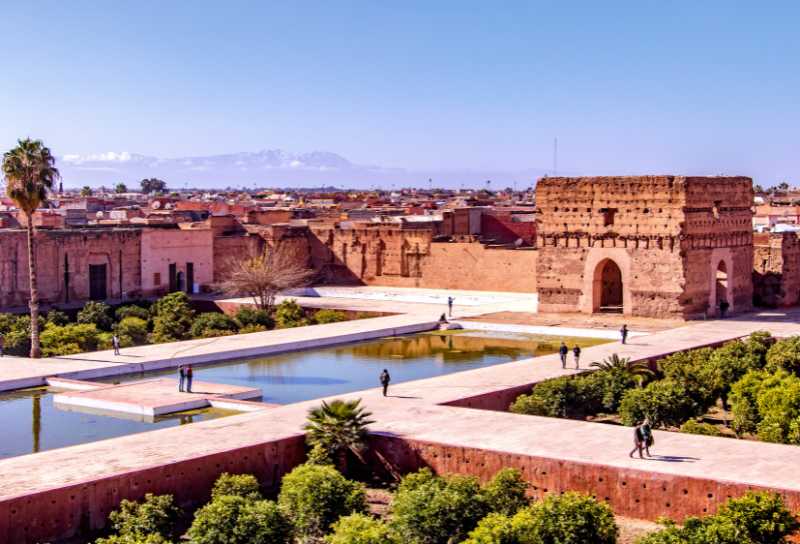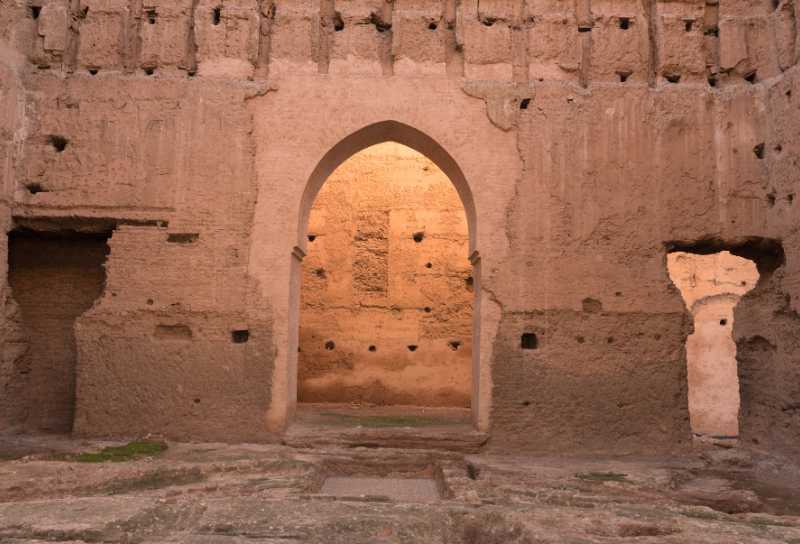Thanks to its gorgeous palaces, beautiful riads, luxury spas, five-star restaurants, and more, Marrakech is known as a city of luxury.

Anyone who visits this city is sure to be mesmerized by its culture, beauty, and history.
One of the most popular things to do in Marrakech is to visit El Badi Palace. Commissioned by Sultan Ahmad al-Mansur of the Saadian dynasty in the late 1570s, construction continued throughout his reign, and El Badi Palace became one of the finest in Morocco.
Overview of El Badi Palace
While El Badi Palace is a place of ruins now, it was once a beautiful sight, full of ornate embellishments, symbols, and tradition.
However, despite the fact that most of the site is now in ruins, that does not mean that it isn’t worth a visit.
The ruins of El Badi Palace are quite a sight to see. Large and expansive, the palatial ruins allow you plenty of space to roam without feeling crowded near other people.
In its prime, the palace had more than 350 rooms, a fountain, a pool, gardens, a large courtyard, and much more.
The History and Culture of El Badi Palace
Because of its sheer size and beauty, El Badi Palace was a great symbol of power. It was a lively palace that held huge feasts, receptions, and celebrations.
It symbolized wealth, honor, and prosperity, which goes along with Marrakech’s reputation as a city of luxury.
Even though El Badi Palace is in ruins now, it still contributes to life and culture in Marrakech.
In fact, the tall clay walls of the ruins provide a home for many storks, and these large, graceful birds have become a cultural symbol of El Badi Palace and many of the surrounding restaurants and cafes are named after them.
The Palace’s Construction
Construction of El Badi Palace began in 1578 under sultan Ahmad al-Mansur of the Saadian dynasty. Construction began as a celebration to honor the sultan after being victorious against the Portuguese force.
Completing the construction of El Badi Palace took about 25 years, and the results were incredible. In addition to hundreds of rooms, the palace also had stables, dungeons, and even summer pavilions.
The Palace’s Decline

Unfortunately, El Badi Palace’s opulence did not last forever. Several historical and political factors led to its decline, namely the fall of the Saadians and the ascension of the Alaouite dynasty.
While the first Alaouite sultan, Moulay Rashid, lived in the palace for a while, the second Alaouite sultan, Moulay Isma’il ibn Sharif refused to live there.
He ordered that the entire palace be stripped of all of its contents, decorations, and materials. He then ordered that the spoils of El Badi be used at his new palace in Meknes.
After that, El Badi Palace was never the same. Over the centuries, it has fallen into ruin and disrepair. However, it is still a gorgeous site and boasts many tourists and onlookers every year.
The Architecture of El Badi Palace
In its prime, El Badi Palace was nothing short of magnificent. It had over 350 rooms, a large courtyard, a pool, a fountain, and so much more.
Today, the Central Courtyard is one of the main attractions of El Badi Palace.
The Courtyard
This gorgeous courtyard houses four sunken gardens that have been built into the ground, which gives the palace a feeling that’s almost surreal.
These gardens are separated by large pools. Every part of the courtyard was meticulously designed and points back to the grandiosity of the palace during its prime.
Extensive Amenities
El Badi Palace boasted more than just rooms, gardens, pools, and fountains: it also housed summer pavilions, stables, and dungeons.
The summer pavilions were located on each side of the main courtyard. The Crystal Pavilion was on the east side and the Koubba el Hamsiniya (The Fifty Pavilion) was to the west. For the most part, only the foundations survive.
To the south of the courtyard stood the palace stables, and close to them were the dungeons.
Though some of the dungeons were possibly used by servants as duty rooms, most of them were used as a state prison facility into the last century.
Koutoubia Minbar
One of the most popular attractions of El Badi Palace is the Koutoubia Minbar, or the prayer pulpit.
Located in a room to the west of the courtyard, this gorgeous pulpit is a testament to the talent and skill of the artisans.
Full of intricate, ornate wooden carvings from the top to the bottom, there is nothing quite like the Koutoubia Minbar. If you’re ever visiting Marrakech, it — and the palace — are must-see destinations.
What to Expect During Your Visit
While El Badi Palace is full of breathtaking beauty and majesty, it also has specific rules for its operation, and it’s important to know these rules before you plan your visit. Otherwise, you may not be fully prepared for the experience.
Hours of Operation: 9:00am to 5:00pm every day
Location: El Badi Palace is in a great location. It’s a 10-minute walk from Jemaa al Fna square, a 15-minute walk from the mosque, and a 7-minute stroll from the Saadian Tombs.
Admission Cost: Children can always visit for free, but adults pay 70 dirhams to enter the palace.
Recommended Visit Duration: To have a truly comprehensive and rewarding experience at El Badi Palace, we recommend setting at least an hour or two aside to explore and experience the palace.
Dress Code: While there is no specific dress code to enter El Badi Palace, visitors are advised to dress modestly and appropriately for the weather conditions.
Special Experience: There’s a room at the palace that streams a video presentation commemorating and honoring the palace’s opulence and grandeur. It plays in multiple languages to accommodate all visitors.
Conclusion
Once a brilliant, gorgeous building, El Badi Palace unfortunately fell into ruin after being plundered and neglected for centuries.
However, the work, skill, and craftsmanship that went into building the palace are still apparent today, making it truly worth a visit.
If you’re planning on visiting Marrakech and want a truly unique, immersive experience, then you should consider visiting El Badi Palace. You’ll leave impressed and inspired by everything the palace has to offer.